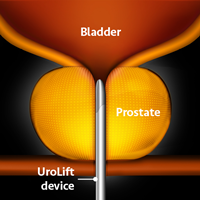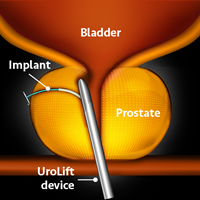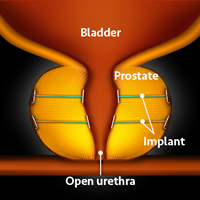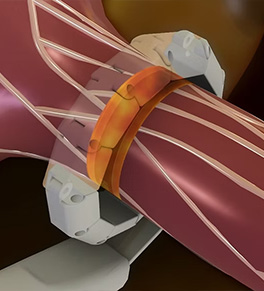UroLift® (Prostatic Urethral Lift)
 An enlarged prostate — a noncancerous condition known as benign prostatic hyperplasia (BPH) — causes urinary tract symptoms that affect the majority of men after age 50. Until recently, treatment options were largely limited to medications or major surgery.
An enlarged prostate — a noncancerous condition known as benign prostatic hyperplasia (BPH) — causes urinary tract symptoms that affect the majority of men after age 50. Until recently, treatment options were largely limited to medications or major surgery.
UCI Health urology specialists offer the latest BPH treatment, which is known as a prostatic urethral lift. This minimally invasive procedure using the UroLift® device provides excellent outcomes for BPH sufferers.
What is a prostatic urethral lift?
A prostatic urethral lift treatment is an innovative approach to treating BPH. The UroLift device delivers tiny stainless-steel implants that lift or hold the enlarged prostate tissue out of the way so that it no longer blocks the urethra, the tube that carries urine from your bladder out of your body. There is no cutting, heating or removal of prostate tissue.
Clinical studies have shown that the treatment is safe and effective in relieving lower urinary tract symptoms due to BPH without compromising sexual function. The goal is to relieve symptoms so you can get back to your life and resume your daily activities.
The most common side effects are light blood in the urine, some pain or discomfort when urinating, some increased urge to go as well as mild discomfort in the pelvic area. These side effects typically go away in two to four weeks after the procedure.
Advantages of the UroLift prostatic urethral lift:
- More effective than medications at relieving BPH symptoms
- Can be performed as an outpatient procedure under local anesthesia in your physician’s office
- No need for a catheter after the procedure
- Fewer risks and complications than surgical procedures such as TURP
- Preservation of sexual function
- No chance of retrograde ejaculation (where semen goes into bladder instead of out the tip of penis)
- Return to normal activity in days not months
- Replaces need for ongoing BPH medications
- Implants are permanent
Is it safe?
The U.S. Food & Drug Administration approved the use of UroLift in 2013, based on results from 19 clinical study publications and four years of published clinical data.
Who is a candidate for the UroLift procedure?
You may be a candidate for the procedure if you:
- Have mild to moderate BPH symptoms and medications do not work
- Have mild to moderate BPH symptoms and do not wish to take daily medications
- Have moderate or severe BPH symptoms and are too ill to undergo other treatments
- Have BPH symptoms caused by enlarged lateral lobes of the prostate with mild or no median lobe enlargement
You may not be a good candidate if you have an obstructive or protruding median lobe of the prostate or a prostate with a volume greater than 80cc. A thorough evaluation by an experienced urologist can determine whether or not a prostate lift is appropriate for you.
How the UroLift prostatic urethral lift works 
An enlarged prostate compresses on the urethra, making it difficult for urine to flow. The urologist uses the UroLift device to place tiny stainless-steel implants that hold the prostate lobes apart, like open curtains on a window. This relieves compression on the urethra, which allows urine to flow normally again.
Step 1 (top image): The UroLift device is placed through the obstructed urethra to access the enlarged prostate.

Step 2 (middle): Tiny implants are permanently placed to lift and hold the enlarged prostate tissues away from the urethra. The implants are attached onto the prostate tissue through a small needle attached to the UroLift device.
Step 3 (bottom): UroLift is removed, leaving an open urethra that relieves the urinary symptoms of BPH.









